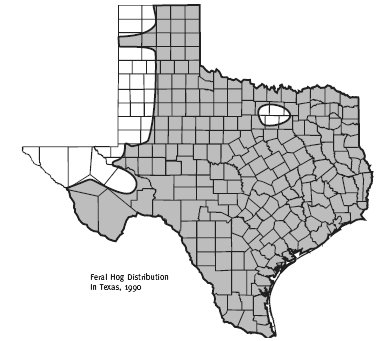Feral hogs are highly adaptable. Their toughness combined with their ability to eat just about anything has allowed them to expand into a varity of habitats. In fact, feral hogs are distributed throughout much of Texas and, in general, co-inhabit the range of the white-tailed deer in the state. As such, hog hunting is a popular activity, with a good number of hogs harvesting during the deer hunting season.
The highest feral hog population densities occur in East, South, and Central Texas. North and West Texas have very low or non-existent populations because of low water availability. However, recent reports indicate that hog populations are beginning to expand into these habitats and increase in these areas. There is currently an estimated feral hog population in excess of 1.5 million animals in Texas.

The increase in the feral hog population and distribution is due in part to intentional trapping and releasing, improved habitat, and increased wildlife management. In addition, improved animal husbandry such as disease eradication, limited natural predators, and high reproductive potential have also allowed the feral hog population to thrive.
There seem to be very few inhibiting factors that can slow the hog population growth. Their distribution in Texas is really only limited by extreme arid conditions, but they may move into these “marginal” areas as the population continues to grow. Most areas of the state that can support feral hogs already have them, but we will all have to wait and see if they continue to move into new areas. With a population size in excess of 1.5 million animals, Texas has more than enough feral hogs. And that’s bad news for farmers and ranchers, but good news for those ready to head out hog trapping or hunting in an attempt to control feral hog numbers.
Any idea which county has highest count of feral hogs?